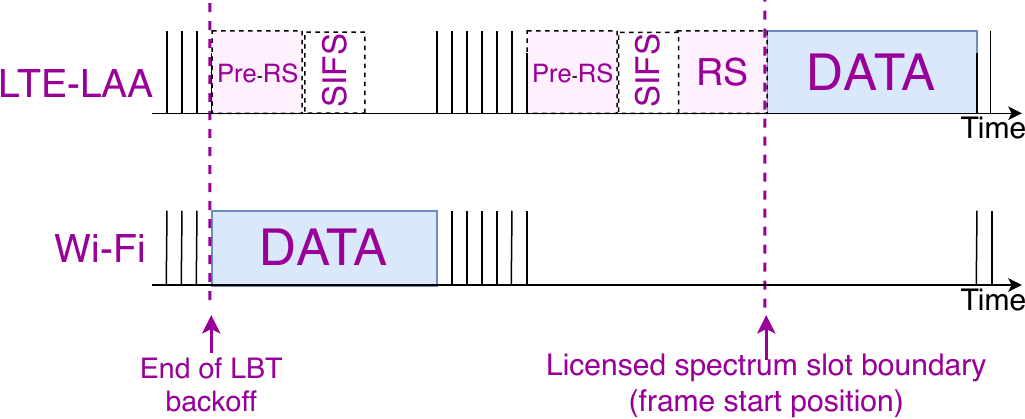LTE License-Assisted Access (LTE-LAA) / NR-U Networks
Growing requirements for cellular network capacity made 3GPP consortium introduce LTE License-Assisted Access (LTE-LAA) technology, which implies unlicensed spectrum exploitation. Since these frequencies are already occupied by other technologies, such as Wi-Fi, it is vital to assure fair and efficient sharing of the unlicensed bands by LTE-LAA and Wi-Fi devices. Hence, LTE-LAA uses the Listen Before Talk channel access method, the principle of which is similar to CSMA/CA implemented in Wi-Fi.
Specifically, similar to Wi-Fi, an LTE-LAA base station performs the backoff procedure before every transmission attempt. However, the base station can only start LTE-LAA data transmission at licensed spectrum slot boundaries, which results in an extremely long vulnerable period from the end of the backoff procedure until the slot boundary. During such a vulnerable period other devices, e.g., Wi-Fi stations, can occupy the channel, canceling the LTE-LAA transmission. To protect LTE-LAA transmissions, many developers propose sending a reservation signal (RS) during the whole vulnerable period to blocks Wi-Fi stations. However, there are several disadvantages concerning the RS usage, especially when Wi-Fi stations use RTS/CTS mechanism. In particular, RS leads to asymmetric collisions: if a Wi-Fi station transmits an RTS and a collision with the LTE-LAA base station occurs, the duration of the RS may be longer than the collided Wi-Fi frame, so LTE-LAA payload is not affected.

WNL members have published a number of papers on the coexistence of Wi-Fi and LTE networks in the unlicensed spectrum. First, the WNL team has investigated the performance of LBT without RS. According to the obtained results, the fair and efficient coexistence of Wi-Fi and LTE-LAA networks is almost impossible in existed LTE-LAA networks, and the usage of RS is inevitable. However, WNL Lab scientific results have shown that LBT without RS can be used in NR-U networks, which is currently being developed successor of the LTE-LAA.
Apart from that, the WNL team has designed a modification of LBT with RS, which utilizes the RS not only for blocking the Wi-Fi stations but also for collision resolution. We have developed an analytical model of the proposed solution and show that LTE-LAA performance can be improved without Wi-Fi network performance degradation.
The achieved results were presented at several international conferences (IFIP Networking 2019, IEEE PIMRC 2019, IEEE BlackSeaCom 2019). Also, the developed method for collision resolution using the RS was presented at the 2019 July IEEE 802.11 Coexistence Workshop (http://grouper.ieee.org/groups/802/11/Workshops/2019-July-Coex/2019-07-Coex-agenda-2.htm).
